story and photos by Kayte Deioma
Ok. I admit that I can be a bit of a cultural heathen when it comes to visiting the museums of the world,
mostly because it means spending the day inside when I want to be out exploring. I traveled to Berlin with my friend Julie Bartolotto, the executive director of the Historical Society of Long Beach, who is in the process of planning a permanent home for the Society’s historical collection
a museum. Of course she wants to look at museums, so what can I do? Pray for rain so I won’t feel bad about being inside!
The universe obligingly provides the precipitation, so the next hard decision is which museums to visit. There are 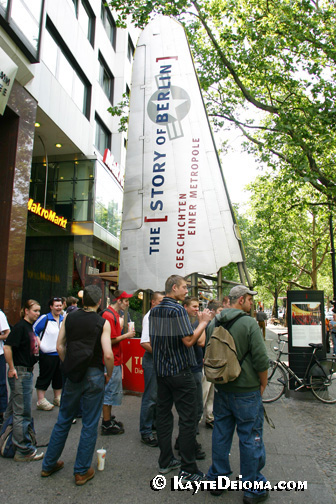 multiple history museums to choose from in Berlin, as well as a panoply of art and culture museums. My interest is sparked by the Story of Berlin museum, which will take us from the city’s inception through it’s times of prosperity, turmoil, division, and reunification up to the present day. If we only get one rainy day, then at least we’ll have an overview of the city’s history.
multiple history museums to choose from in Berlin, as well as a panoply of art and culture museums. My interest is sparked by the Story of Berlin museum, which will take us from the city’s inception through it’s times of prosperity, turmoil, division, and reunification up to the present day. If we only get one rainy day, then at least we’ll have an overview of the city’s history.
The Story of Berlin is a permanent exhibition, opened in 1999, housed in the Ku’Damm Karree shopping center. The location was chosen to incorporate the nuclear fallout shelter built under the complex when it was constructed in the early 70’s. A guided tour of the “atomic bunker” is part of the Story of Berlin experience. Since an English language tour of the bunker is about to begin as we arrive, we decide to start our experience underground.
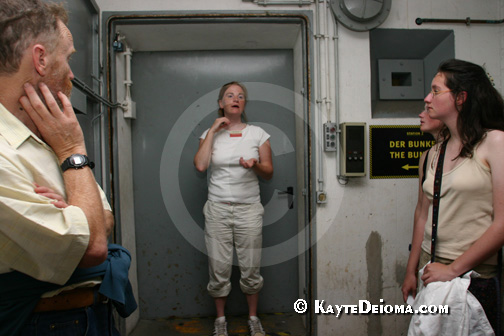 We follow our young guide out of the shopping center and into the parking structure, then down several flights of stairs. We crowd into an antechamber in front of a heavy metal door with the other English-speaking visitors from Georgia, Australia, Denmark and Argentina. We’re in the decontamination chamber. In a brief orientation the guide explains that the bunker was built to house 3592 people. She is refreshingly candid about her opinions of the usefulness of the bunker in a real nuclear crisis, given that it was only stocked with enough supplies to last 14 days. However, the first 3592 people still have someplace to duck for cover in case of current biological or chemical threats which might clear more quickly than nuclear fallout.
We follow our young guide out of the shopping center and into the parking structure, then down several flights of stairs. We crowd into an antechamber in front of a heavy metal door with the other English-speaking visitors from Georgia, Australia, Denmark and Argentina. We’re in the decontamination chamber. In a brief orientation the guide explains that the bunker was built to house 3592 people. She is refreshingly candid about her opinions of the usefulness of the bunker in a real nuclear crisis, given that it was only stocked with enough supplies to last 14 days. However, the first 3592 people still have someplace to duck for cover in case of current biological or chemical threats which might clear more quickly than nuclear fallout.
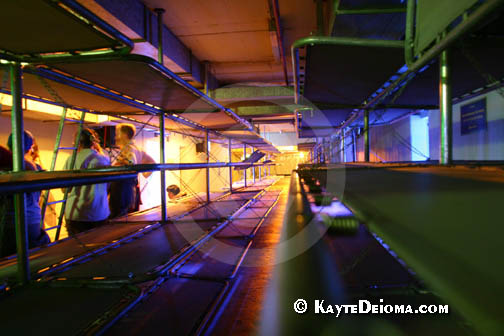 When we pass through the metal door, eerie colored lights hint at the vast expanse of cots hung four deep, floor to ceiling, extending in tight rows into the darkness. Our guide shows us around the perimeter of the room, where glassed-off doors allow a glimpse into men’s and women’s sanitation areas, the 47-bed infirmary, the generator room, the air filtration system and the kitchen full of unlabeled gold cans with a notice on the window stating “no provisions are stored here.”
When we pass through the metal door, eerie colored lights hint at the vast expanse of cots hung four deep, floor to ceiling, extending in tight rows into the darkness. Our guide shows us around the perimeter of the room, where glassed-off doors allow a glimpse into men’s and women’s sanitation areas, the 47-bed infirmary, the generator room, the air filtration system and the kitchen full of unlabeled gold cans with a notice on the window stating “no provisions are stored here.”
The idea of sharing this un-air-conditioned bunker with 3491 other sweaty cranky souls for 14 days only to emerge to…what? Maybe world leaders should have their summits here. Gloomy thoughts for a rainy day. We head back upstairs, through the mall to the main exhibition. We opt not to get the headsets with the narrated tour, but rather to read our way through since everything is in German and English.
We enter the exhibition through a courtyard, representative of the German 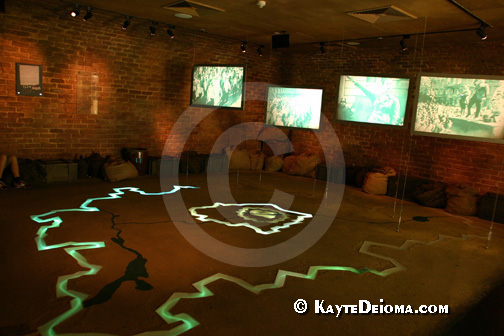 and Turkish people and neighborhoods of the city. A friendly staff person takes our tickets. The inner doors open. We step through into the Time Tunnel stretching ahead of us. To the left, a jagged bull’s-eye of green light on the floor outlines the borders of Berlin at it’s founding in 1237 as a village on the banks of the Spree, and its expanded borders in 1648, 1919 and 1920. That original village is now Berlin’s Museum Island. A video on the wall flashes images and dates of Berlin’s history as a center of trade and commerce accompanied by German narration.
and Turkish people and neighborhoods of the city. A friendly staff person takes our tickets. The inner doors open. We step through into the Time Tunnel stretching ahead of us. To the left, a jagged bull’s-eye of green light on the floor outlines the borders of Berlin at it’s founding in 1237 as a village on the banks of the Spree, and its expanded borders in 1648, 1919 and 1920. That original village is now Berlin’s Museum Island. A video on the wall flashes images and dates of Berlin’s history as a center of trade and commerce accompanied by German narration.
We step across the Time Tunnel hallway into a glowing holographic tube 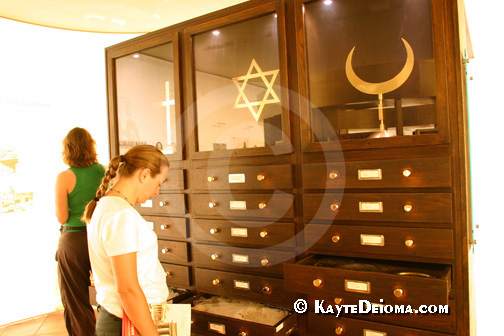 where the entire circular outer wall of back-lit text and illustrations tells the story of how Christianity, Judaism and Islam have influenced the history of the city. In the center of the room, large photographs depicting religious rites surround a tall chest of drawers in three columns topped respectively by a Cross, a Star of David and a Crescent. Each glass-covered drawer contains artifacts used for religious ceremony. In one drawer a Christian baptismal gown, in another a Jewish wedding veil, in a third ritual silver dishes from Ramadan.
where the entire circular outer wall of back-lit text and illustrations tells the story of how Christianity, Judaism and Islam have influenced the history of the city. In the center of the room, large photographs depicting religious rites surround a tall chest of drawers in three columns topped respectively by a Cross, a Star of David and a Crescent. Each glass-covered drawer contains artifacts used for religious ceremony. In one drawer a Christian baptismal gown, in another a Jewish wedding veil, in a third ritual silver dishes from Ramadan.
Back in the Time Tunnel I am a bit overwhelmed by the lists of dates and 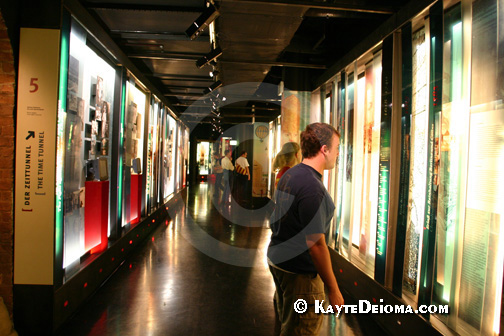 significant events in history and all the interactive panels with video clips. I move on to admire the series of Prussian military uniforms while Julie diligently reads all the important happenings of the 18th century under four rulers named Frederick. Next door, I join life-size figures of the intellectual elite lounging in a Biedermeier room juxtaposed against a wooden barricade with a burning red background. Symbolic of the cultural advances in Berlin before, and the decline after the unsuccessful 1848 revolution.
significant events in history and all the interactive panels with video clips. I move on to admire the series of Prussian military uniforms while Julie diligently reads all the important happenings of the 18th century under four rulers named Frederick. Next door, I join life-size figures of the intellectual elite lounging in a Biedermeier room juxtaposed against a wooden barricade with a burning red background. Symbolic of the cultural advances in Berlin before, and the decline after the unsuccessful 1848 revolution.
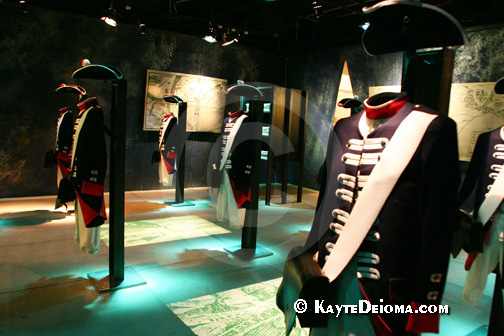 Moving down the hall, a starkly lit display of 23 white architectural models of Berlin’s public buildings shows how the city’s architecture is intertwined with its history. A multimedia display of materials and video monitors depict the changes brought by the industrial revolution. Sporadically assembled artifacts represent the transition to mechanized industry.
Moving down the hall, a starkly lit display of 23 white architectural models of Berlin’s public buildings shows how the city’s architecture is intertwined with its history. A multimedia display of materials and video monitors depict the changes brought by the industrial revolution. Sporadically assembled artifacts represent the transition to mechanized industry.
I follow what look like railroad tracks laid in perspective through a tunnel that dead-ends at a painting of a man beating a horse. I must have missed something. I retrace my steps to see what I’m supposed to be seeing. I should have gotten the headset.
Julie read the panels. The three segments of this “portal” show the 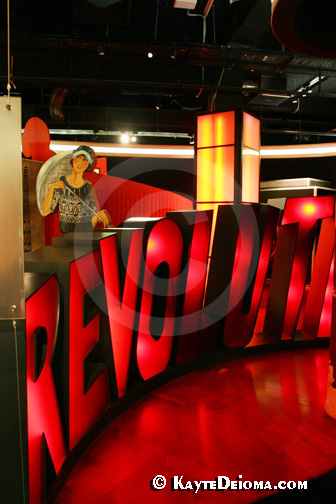 upper class, the middle class and the “urban proletarians” respectively. In the latter segment, where the man is beating the horse, a brightly colored abacus looks out of place among drab metal kitchen utensils set against a backdrop of a life-size black-and-white turn-of-the-last-century photo of a woman with her children. As an example of classism, Julie draws my attention to a painting from the time depicting lower-class townsfolk as a crowd of plump sunbathers, naked babies and groping couples at the beach.
upper class, the middle class and the “urban proletarians” respectively. In the latter segment, where the man is beating the horse, a brightly colored abacus looks out of place among drab metal kitchen utensils set against a backdrop of a life-size black-and-white turn-of-the-last-century photo of a woman with her children. As an example of classism, Julie draws my attention to a painting from the time depicting lower-class townsfolk as a crowd of plump sunbathers, naked babies and groping couples at the beach.
We move through time to a room with a three-wheeled car and cutouts of women from the roaring 20’s behind giant red letters spelling out REVOLUTION. It looks very retro-modern and cool – more concept than content. There’s a little movie theater with a film playing in German. We don’t stop. I must have blinked and missed WWI, or turned the wrong corner. Maybe it was covered in the film. I’m not looking back.
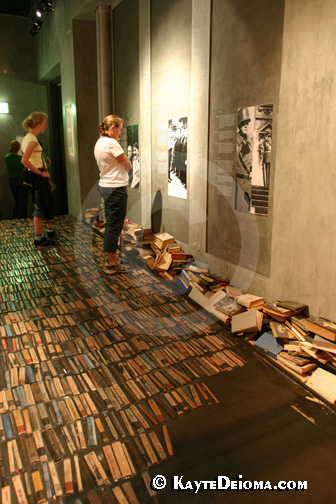 We follow arrows around a corner down a long stairwell plastered with photos of politicians, intellectuals and movie stars. Empty frames indicate those who were lost under the Third Reich. As we descend the stairs, we hear the voices of democratic speeches from above transitioning to the inflammatory speeches of Nazi Germany below. The heavy steel door at the bottom of the dark stairwell forewarns us that we are now entering the darkest chapter in Berlin’s history. On the other side of the door is a hall paved with the spines of books that were burned by the Nazis in 1933. Additional volumes are heaped along the walls. I GET this one, and it GETS me. The goosebumps are starting as I move past the window with “Jude,” German for Jew, scrawled big.
We follow arrows around a corner down a long stairwell plastered with photos of politicians, intellectuals and movie stars. Empty frames indicate those who were lost under the Third Reich. As we descend the stairs, we hear the voices of democratic speeches from above transitioning to the inflammatory speeches of Nazi Germany below. The heavy steel door at the bottom of the dark stairwell forewarns us that we are now entering the darkest chapter in Berlin’s history. On the other side of the door is a hall paved with the spines of books that were burned by the Nazis in 1933. Additional volumes are heaped along the walls. I GET this one, and it GETS me. The goosebumps are starting as I move past the window with “Jude,” German for Jew, scrawled big.
In the Third Reich exhibit, I once again bump up against those high-concept metaphors that I see, but don’t immediately grasp. Aligned footprints on the floor (the masses who went along with everything), swastika turnstiles, a white room (the resistance), a bombed out hole (war and destruction).
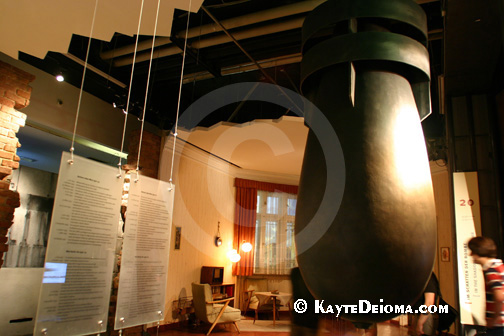 As we move through this period of history, television screens playing historical footage start to appear. They become more prominent as we move past the war into the rebuilding of the 50’s and 60s, including news reports of the Berlin airlift. A display shows two 1950s living rooms representing life in East and West Berlin with a bomb suspended through the ceiling between them. The differences are subtle, the most obvious being the colored TV in the West and black and white in the East.
As we move through this period of history, television screens playing historical footage start to appear. They become more prominent as we move past the war into the rebuilding of the 50’s and 60s, including news reports of the Berlin airlift. A display shows two 1950s living rooms representing life in East and West Berlin with a bomb suspended through the ceiling between them. The differences are subtle, the most obvious being the colored TV in the West and black and white in the East.
The wall is built. In an effective visual presentation, back to back TV sets 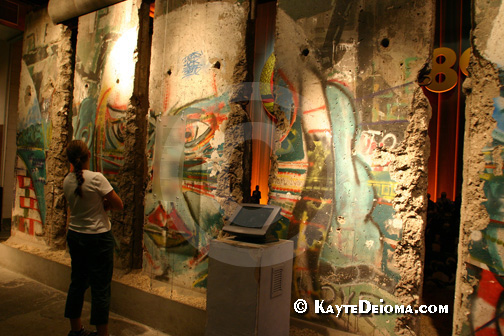 show footage of what surveillance cameras recorded on the East and West sides of the wall. More TV screens show footage of news reports of changes in the Soviet Union. Four segments of the original wall stand here. We hear the voice of Ronald Reagan saying “Mr. Gorbachev, tear down this wall!” as thousands cheer. We see the German and English news reports of GDR secretary general Erich Honecker declaring the borders open between East and West. Hundreds of thousands of people fill the streets and clamber on top of the wall. I’ve held up until now, but the tissue comes out as I remember watching this original footage from my apartment in Glendale, CA.
show footage of what surveillance cameras recorded on the East and West sides of the wall. More TV screens show footage of news reports of changes in the Soviet Union. Four segments of the original wall stand here. We hear the voice of Ronald Reagan saying “Mr. Gorbachev, tear down this wall!” as thousands cheer. We see the German and English news reports of GDR secretary general Erich Honecker declaring the borders open between East and West. Hundreds of thousands of people fill the streets and clamber on top of the wall. I’ve held up until now, but the tissue comes out as I remember watching this original footage from my apartment in Glendale, CA.
I regain my composure and look for Julie, already at the other end of the final room of the exhibit, the rebuilding. I walk past a car
– I think it might have been Erich Honecker’s, a moped with a protest banner hanging overhead,
a little room with a desk and books piled all around
. I’m past my information absorption limit. I tread gratefully over a field of red and green East German traffic-signal men to the elevator back up to the shopping mall and on to
lunch.
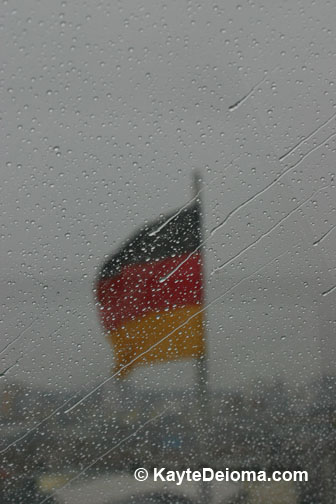

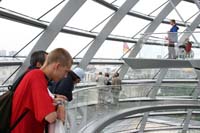 The Reichstag, the German Bundestag or parliament building, is an architectural and environmental wonder, rain or shine. On a sunny day, the wait to get into the Reichstag to visit the dome can be over an hour. This may be due as much to the time it takes to get through security and the limited capacity of the elevators as much as the occupancy limits of the dome itself. In any case, rain significantly shortens the wait, making this a good opportunity to visit the Reichstag Dome.
The Reichstag, the German Bundestag or parliament building, is an architectural and environmental wonder, rain or shine. On a sunny day, the wait to get into the Reichstag to visit the dome can be over an hour. This may be due as much to the time it takes to get through security and the limited capacity of the elevators as much as the occupancy limits of the dome itself. In any case, rain significantly shortens the wait, making this a good opportunity to visit the Reichstag Dome.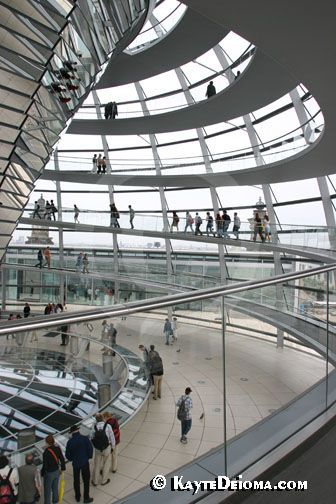 German Republic. Hitler seized power in 1933. With a fire in the Reichstag he put a quick symbolic and real end to parliamentary democracy in Germany. The ruined Reichstag building was just on the west side of the Berlin divide after WWII. The Berlin Wall, built in the 1960s, ran right along side it. It was restored to some extent, but with the new capitol of the Federal Republic of Germany in Bonn, it was used primarily for non-parliamentary purposes. After the Wall came down, when the capitol of Germany was moved from Bonn back to Berlin, the Reichstag was brought back into use for parliament business.
German Republic. Hitler seized power in 1933. With a fire in the Reichstag he put a quick symbolic and real end to parliamentary democracy in Germany. The ruined Reichstag building was just on the west side of the Berlin divide after WWII. The Berlin Wall, built in the 1960s, ran right along side it. It was restored to some extent, but with the new capitol of the Federal Republic of Germany in Bonn, it was used primarily for non-parliamentary purposes. After the Wall came down, when the capitol of Germany was moved from Bonn back to Berlin, the Reichstag was brought back into use for parliament business.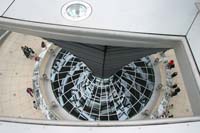 The transparent glass dome, as well as glass interior walls and glass panels looking into the plenary chamber from all sides and from above are designed to represent the transparency of the united German government. A cone of mirrors in the center of the dome, which extends through to the lower floors, gathers solar energy for heating and cooling, while reflecting natural light to the chambers below. With tourists looking on from 8 a.m. to midnight, there are no secrets here.
The transparent glass dome, as well as glass interior walls and glass panels looking into the plenary chamber from all sides and from above are designed to represent the transparency of the united German government. A cone of mirrors in the center of the dome, which extends through to the lower floors, gathers solar energy for heating and cooling, while reflecting natural light to the chambers below. With tourists looking on from 8 a.m. to midnight, there are no secrets here.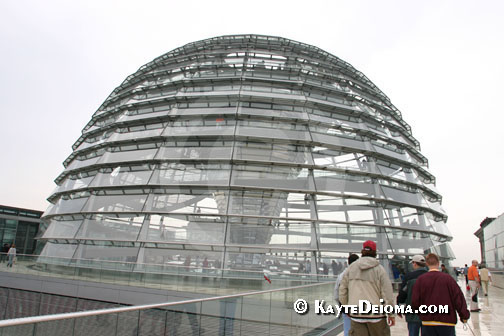 elevator to the dome entrance. Once inside the cupola, information panels around the base of the central mirrored cone provide the history of the building and its reconstruction. Between the circle of history and the central cone are glass panels, which look down into the plenary chamber when it is in session. When the chamber is not in use, these glass panels reflect back up to the dome, creating the effect of being inside a giant disco ball.
elevator to the dome entrance. Once inside the cupola, information panels around the base of the central mirrored cone provide the history of the building and its reconstruction. Between the circle of history and the central cone are glass panels, which look down into the plenary chamber when it is in session. When the chamber is not in use, these glass panels reflect back up to the dome, creating the effect of being inside a giant disco ball.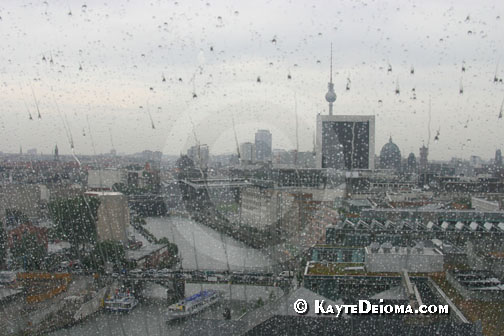 change focus through the translucent noise of the beaded water on glass to the shifting grays of the moisture-laden sky. A thick swath of the Spree River cuts through the concrete, metal and glass skyline, past the remodeled Friedrichstrasse Station. The beaded needle of the Fernsehturm (TV Tower) peeks out from behind the rectangle of the Internationale Handelszentrum ( World Trade Center). As you climb higher, the muted beige and green of the Brandenburg Gate comes into view behind the German flag flying over one of the four corner towers of the Reichstag building. A panoramic guide helps to identify a few landmarks on the horizon.
change focus through the translucent noise of the beaded water on glass to the shifting grays of the moisture-laden sky. A thick swath of the Spree River cuts through the concrete, metal and glass skyline, past the remodeled Friedrichstrasse Station. The beaded needle of the Fernsehturm (TV Tower) peeks out from behind the rectangle of the Internationale Handelszentrum ( World Trade Center). As you climb higher, the muted beige and green of the Brandenburg Gate comes into view behind the German flag flying over one of the four corner towers of the Reichstag building. A panoramic guide helps to identify a few landmarks on the horizon.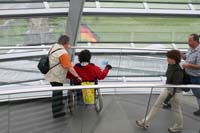 The dome is open at the top, allowing waste air from the chamber below to escape and bringing fresh air into the building. There is a circular bench in the center of the viewing platform, but since it is under the opening, it gets rained on. A better bet to find a seat out of the rain might be the Käfer Café just outside the dome, if it isn’t fully booked as it was on our visit.
The dome is open at the top, allowing waste air from the chamber below to escape and bringing fresh air into the building. There is a circular bench in the center of the viewing platform, but since it is under the opening, it gets rained on. A better bet to find a seat out of the rain might be the Käfer Café just outside the dome, if it isn’t fully booked as it was on our visit.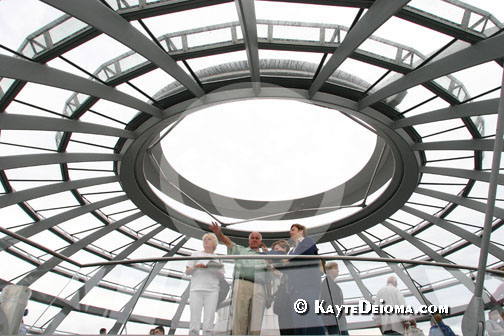 Visitors who wish to attend plenary sittings can view the proceedings from the mezzanine level that extends down into the plenary chambers like a balcony in a theatre. There is a separate line from the lobby to go up to the mezzanine.
Visitors who wish to attend plenary sittings can view the proceedings from the mezzanine level that extends down into the plenary chambers like a balcony in a theatre. There is a separate line from the lobby to go up to the mezzanine.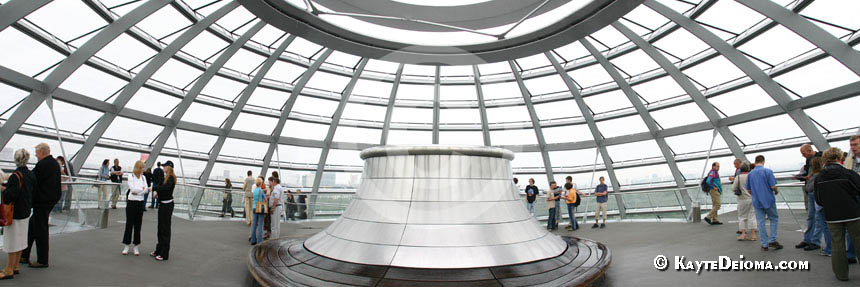
 multiple history museums to choose from in Berlin, as well as a panoply of art and culture museums. My interest is sparked by the Story of Berlin museum, which will take us from the city’s inception through it’s times of prosperity, turmoil, division, and reunification up to the present day. If we only get one rainy day, then at least we’ll have an overview of the city’s history.
multiple history museums to choose from in Berlin, as well as a panoply of art and culture museums. My interest is sparked by the Story of Berlin museum, which will take us from the city’s inception through it’s times of prosperity, turmoil, division, and reunification up to the present day. If we only get one rainy day, then at least we’ll have an overview of the city’s history. We follow our young guide out of the shopping center and into the parking structure, then down several flights of stairs. We crowd into an antechamber in front of a heavy metal door with the other English-speaking visitors from Georgia, Australia, Denmark and Argentina. We’re in the decontamination chamber. In a brief orientation the guide explains that the bunker was built to house 3592 people. She is refreshingly candid about her opinions of the usefulness of the bunker in a real nuclear crisis, given that it was only stocked with enough supplies to last 14 days. However, the first 3592 people still have someplace to duck for cover in case of current biological or chemical threats which might clear more quickly than nuclear fallout.
We follow our young guide out of the shopping center and into the parking structure, then down several flights of stairs. We crowd into an antechamber in front of a heavy metal door with the other English-speaking visitors from Georgia, Australia, Denmark and Argentina. We’re in the decontamination chamber. In a brief orientation the guide explains that the bunker was built to house 3592 people. She is refreshingly candid about her opinions of the usefulness of the bunker in a real nuclear crisis, given that it was only stocked with enough supplies to last 14 days. However, the first 3592 people still have someplace to duck for cover in case of current biological or chemical threats which might clear more quickly than nuclear fallout. When we pass through the metal door, eerie colored lights hint at the vast expanse of cots hung four deep, floor to ceiling, extending in tight rows into the darkness. Our guide shows us around the perimeter of the room, where glassed-off doors allow a glimpse into men’s and women’s sanitation areas, the 47-bed infirmary, the generator room, the air filtration system and the kitchen full of unlabeled gold cans with a notice on the window stating “no provisions are stored here.”
When we pass through the metal door, eerie colored lights hint at the vast expanse of cots hung four deep, floor to ceiling, extending in tight rows into the darkness. Our guide shows us around the perimeter of the room, where glassed-off doors allow a glimpse into men’s and women’s sanitation areas, the 47-bed infirmary, the generator room, the air filtration system and the kitchen full of unlabeled gold cans with a notice on the window stating “no provisions are stored here.” and Turkish people and neighborhoods of the city. A friendly staff person takes our tickets. The inner doors open. We step through into the Time Tunnel stretching ahead of us. To the left, a jagged bull’s-eye of green light on the floor outlines the borders of Berlin at it’s founding in 1237 as a village on the banks of the Spree, and its expanded borders in 1648, 1919 and 1920. That original village is now Berlin’s Museum Island. A video on the wall flashes images and dates of Berlin’s history as a center of trade and commerce accompanied by German narration.
and Turkish people and neighborhoods of the city. A friendly staff person takes our tickets. The inner doors open. We step through into the Time Tunnel stretching ahead of us. To the left, a jagged bull’s-eye of green light on the floor outlines the borders of Berlin at it’s founding in 1237 as a village on the banks of the Spree, and its expanded borders in 1648, 1919 and 1920. That original village is now Berlin’s Museum Island. A video on the wall flashes images and dates of Berlin’s history as a center of trade and commerce accompanied by German narration. where the entire circular outer wall of back-lit text and illustrations tells the story of how Christianity, Judaism and Islam have influenced the history of the city. In the center of the room, large photographs depicting religious rites surround a tall chest of drawers in three columns topped respectively by a Cross, a Star of David and a Crescent. Each glass-covered drawer contains artifacts used for religious ceremony. In one drawer a Christian baptismal gown, in another a Jewish wedding veil, in a third ritual silver dishes from Ramadan.
where the entire circular outer wall of back-lit text and illustrations tells the story of how Christianity, Judaism and Islam have influenced the history of the city. In the center of the room, large photographs depicting religious rites surround a tall chest of drawers in three columns topped respectively by a Cross, a Star of David and a Crescent. Each glass-covered drawer contains artifacts used for religious ceremony. In one drawer a Christian baptismal gown, in another a Jewish wedding veil, in a third ritual silver dishes from Ramadan. significant events in history and all the interactive panels with video clips. I move on to admire the series of Prussian military uniforms while Julie diligently reads all the important happenings of the 18th century under four rulers named Frederick. Next door, I join life-size figures of the intellectual elite lounging in a Biedermeier room juxtaposed against a wooden barricade with a burning red background. Symbolic of the cultural advances in Berlin before, and the decline after the unsuccessful 1848 revolution.
significant events in history and all the interactive panels with video clips. I move on to admire the series of Prussian military uniforms while Julie diligently reads all the important happenings of the 18th century under four rulers named Frederick. Next door, I join life-size figures of the intellectual elite lounging in a Biedermeier room juxtaposed against a wooden barricade with a burning red background. Symbolic of the cultural advances in Berlin before, and the decline after the unsuccessful 1848 revolution. Moving down the hall, a starkly lit display of 23 white architectural models of Berlin’s public buildings shows how the city’s architecture is intertwined with its history. A multimedia display of materials and video monitors depict the changes brought by the industrial revolution. Sporadically assembled artifacts represent the transition to mechanized industry.
Moving down the hall, a starkly lit display of 23 white architectural models of Berlin’s public buildings shows how the city’s architecture is intertwined with its history. A multimedia display of materials and video monitors depict the changes brought by the industrial revolution. Sporadically assembled artifacts represent the transition to mechanized industry. upper class, the middle class and the “urban proletarians” respectively. In the latter segment, where the man is beating the horse, a brightly colored abacus looks out of place among drab metal kitchen utensils set against a backdrop of a life-size black-and-white turn-of-the-last-century photo of a woman with her children. As an example of classism, Julie draws my attention to a painting from the time depicting lower-class townsfolk as a crowd of plump sunbathers, naked babies and groping couples at the beach.
upper class, the middle class and the “urban proletarians” respectively. In the latter segment, where the man is beating the horse, a brightly colored abacus looks out of place among drab metal kitchen utensils set against a backdrop of a life-size black-and-white turn-of-the-last-century photo of a woman with her children. As an example of classism, Julie draws my attention to a painting from the time depicting lower-class townsfolk as a crowd of plump sunbathers, naked babies and groping couples at the beach. We follow arrows around a corner down a long stairwell plastered with photos of politicians, intellectuals and movie stars. Empty frames indicate those who were lost under the Third Reich. As we descend the stairs, we hear the voices of democratic speeches from above transitioning to the inflammatory speeches of Nazi Germany below. The heavy steel door at the bottom of the dark stairwell forewarns us that we are now entering the darkest chapter in Berlin’s history. On the other side of the door is a hall paved with the spines of books that were burned by the Nazis in 1933. Additional volumes are heaped along the walls. I GET this one, and it GETS me. The goosebumps are starting as I move past the window with “Jude,” German for Jew, scrawled big.
We follow arrows around a corner down a long stairwell plastered with photos of politicians, intellectuals and movie stars. Empty frames indicate those who were lost under the Third Reich. As we descend the stairs, we hear the voices of democratic speeches from above transitioning to the inflammatory speeches of Nazi Germany below. The heavy steel door at the bottom of the dark stairwell forewarns us that we are now entering the darkest chapter in Berlin’s history. On the other side of the door is a hall paved with the spines of books that were burned by the Nazis in 1933. Additional volumes are heaped along the walls. I GET this one, and it GETS me. The goosebumps are starting as I move past the window with “Jude,” German for Jew, scrawled big. As we move through this period of history, television screens playing historical footage start to appear. They become more prominent as we move past the war into the rebuilding of the 50’s and 60s, including news reports of the Berlin airlift. A display shows two 1950s living rooms representing life in East and West Berlin with a bomb suspended through the ceiling between them. The differences are subtle, the most obvious being the colored TV in the West and black and white in the East.
As we move through this period of history, television screens playing historical footage start to appear. They become more prominent as we move past the war into the rebuilding of the 50’s and 60s, including news reports of the Berlin airlift. A display shows two 1950s living rooms representing life in East and West Berlin with a bomb suspended through the ceiling between them. The differences are subtle, the most obvious being the colored TV in the West and black and white in the East. show footage of what surveillance cameras recorded on the East and West sides of the wall. More TV screens show footage of news reports of changes in the Soviet Union. Four segments of the original wall stand here. We hear the voice of Ronald Reagan saying “Mr. Gorbachev, tear down this wall!” as thousands cheer. We see the German and English news reports of GDR secretary general Erich Honecker declaring the borders open between East and West. Hundreds of thousands of people fill the streets and clamber on top of the wall. I’ve held up until now, but the tissue comes out as I remember watching this original footage from my apartment in Glendale, CA.
show footage of what surveillance cameras recorded on the East and West sides of the wall. More TV screens show footage of news reports of changes in the Soviet Union. Four segments of the original wall stand here. We hear the voice of Ronald Reagan saying “Mr. Gorbachev, tear down this wall!” as thousands cheer. We see the German and English news reports of GDR secretary general Erich Honecker declaring the borders open between East and West. Hundreds of thousands of people fill the streets and clamber on top of the wall. I’ve held up until now, but the tissue comes out as I remember watching this original footage from my apartment in Glendale, CA.